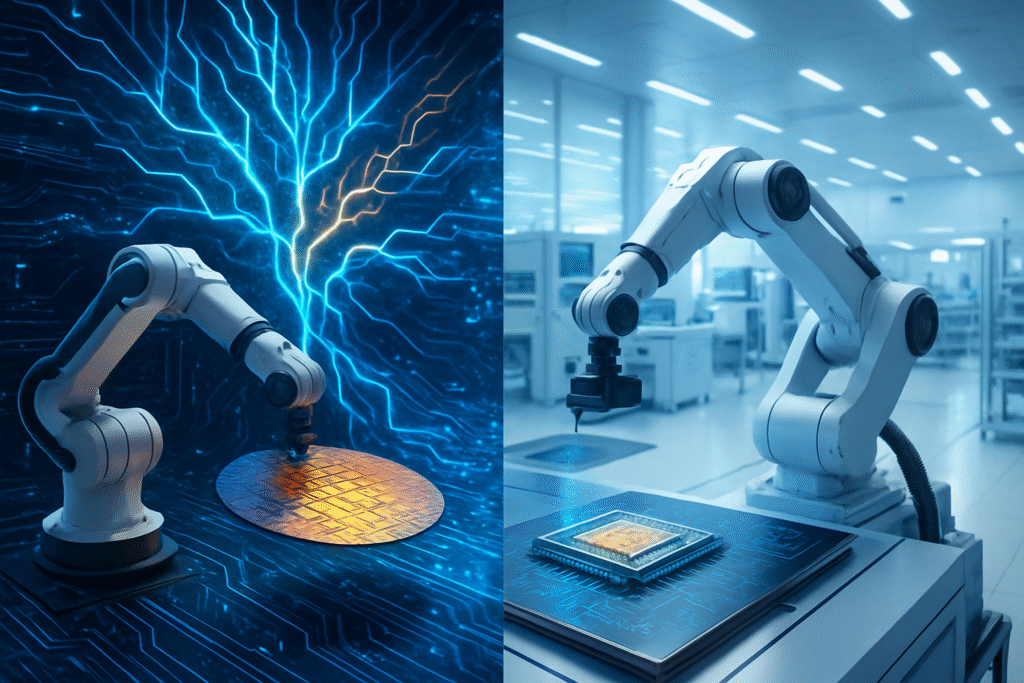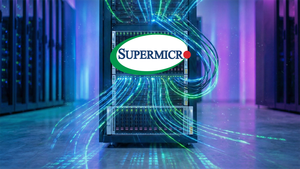
The global semiconductor industry, a foundational pillar of modern technology, is currently experiencing a profound and unprecedented bifurcation as of October 2025. While an "AI Supercycle" is driving insatiable demand for cutting-edge chips, propelling industry leaders to record profits, traditional market segments like consumer electronics, automotive, and industrial computing are navigating a more subdued recovery from lingering inventory corrections. This dual reality presents both immense opportunities and significant challenges for the world's top chip foundries – Taiwan Semiconductor Manufacturing Company (TSMC) (NYSE: TSM), Intel (NASDAQ: INTC), and Samsung (KRX: 005930) – reshaping the competitive landscape and dictating the future of technological innovation.
This dynamic environment highlights a stark contrast: the relentless pursuit of advanced silicon for artificial intelligence applications is pushing manufacturing capabilities to their limits, while other sectors cautiously emerge from a period of oversupply. The immediate significance lies in the strategic reorientation of these foundry giants, who are pouring billions into expanding advanced node capacity, diversifying global footprints, and aggressively competing for the lucrative AI chip contracts that are now the primary engine of industry growth.
Navigating a Bifurcated Market: The Technical Underpinnings of Current Demand
The current semiconductor market is defined by a "tale of two markets." On one side, the demand for specialized, cutting-edge AI chips, particularly advanced GPUs, high-bandwidth memory (HBM), and sub-11nm geometries (e.g., 7nm, 5nm, 3nm, and emerging 2nm), is overwhelming. Sales of generative AI chips alone are forecasted to surpass $150 billion in 2025, with AI accelerators projected to exceed this figure. This demand is concentrated on a few advanced foundries capable of producing these complex components, leading to unprecedented utilization rates for leading-edge nodes and advanced packaging solutions like CoWoS (Chip-on-Wafer-on-Substrate).
Conversely, traditional market segments, while showing signs of gradual recovery, still face headwinds. Consumer electronics, including smartphones and PCs, are experiencing muted demand and slower recovery for mature node semiconductors, despite the anticipated doubling of sales for AI-enabled PCs and mobile devices in 2025. The automotive and industrial sectors, which underwent significant inventory corrections in early 2025, are seeing demand improve in the second half of the year as restocking efforts pick up. However, a looming shortage of mature node chips (40nm and above) is still anticipated for the automotive industry in late 2025 or 2026, despite some easing of previous shortages.
This situation differs significantly from previous semiconductor downturns or upswings, which were often driven by broad-based demand for PCs or smartphones. The defining characteristic of the current upswing is the insatiable demand for AI chips, which requires vastly more sophisticated, power-efficient designs. This pushes the boundaries of advanced manufacturing and creates a bifurcated market where advanced node utilization remains strong, while mature node foundries face a slower, more cautious recovery. Macroeconomic factors, including geopolitical tensions and trade policies, continue to influence the supply chain, with initiatives like the U.S. CHIPS Act aiming to bolster domestic manufacturing but also contributing to a complex global competitive landscape.
Initial reactions from the industry underscore this divide. TSMC reported record results in Q3 2025, with profit jumping 39% year-on-year and revenue rising 30.3% to $33.1 billion, largely due to AI demand described as "stronger than we thought three months ago." Intel's foundry business, while still operating at a loss, is seen as having a significant opportunity due to the AI boom, with Microsoft reportedly committing to use Intel Foundry for its next in-house AI chip. Samsung Foundry, despite a Q1 2025 revenue decline, is aggressively expanding its presence in the HBM market and advancing its 2nm process, aiming to capture a larger share of the AI chip market.
The AI Supercycle's Ripple Effect: Impact on Tech Giants and Startups
The bifurcated chip market is having a profound and varied impact across the technology ecosystem, from established tech giants to nimble AI startups. Companies deeply entrenched in the AI and data center space are reaping unprecedented benefits, while others must strategically adapt to avoid being left behind.
NVIDIA (NASDAQ: NVDA) remains a dominant force, reportedly nearly doubling its brand value in 2025, driven by the explosive demand for its GPUs and the robust CUDA software ecosystem. NVIDIA has reportedly booked nearly all capacity at partner server plants through 2026 for its Blackwell and Rubin platforms, indicating hardware bottlenecks and potential constraints for other firms. AMD (NASDAQ: AMD) is making significant inroads in the AI and data center chip markets with its AI accelerators and CPU/GPU offerings, with Microsoft reportedly co-developing chips with AMD, intensifying competition.
Hyperscalers like Google (NASDAQ: GOOGL), Microsoft (NASDAQ: MSFT), and Amazon (NASDAQ: AMZN) are heavily investing in their own custom AI chips (ASICs), such as Google's TPUs, Amazon's Graviton and Trainium, and Microsoft's rumored in-house AI chip. This strategy aims to reduce dependency on third-party suppliers, optimize performance for their specific software needs, and control long-term costs. While developing their own silicon, these tech giants still heavily rely on NVIDIA's GPUs for their cloud computing businesses, creating a complex supplier-competitor dynamic. For startups, the astronomical cost of developing and manufacturing advanced AI chips creates a massive barrier, potentially centralizing AI power among a few tech giants. However, increased domestic manufacturing and specialized niches offer new opportunities.
For the foundries themselves, the stakes are exceptionally high. TSMC (NYSE: TSM) remains the undisputed leader in advanced nodes and advanced packaging, critical for AI accelerators. Its market share in Foundry 1.0 is projected to climb to 66% in 2025, and it is accelerating capacity expansion with significant capital expenditure. Samsung Foundry (KRX: 005930) is aggressively positioning itself as a "one-stop shop" by leveraging its expertise across memory, foundry, and advanced packaging, aiming to reduce manufacturing times and capture a larger market share, especially with its early adoption of Gate-All-Around (GAA) transistor architecture. Intel (NASDAQ: INTC) is making a strategic pivot with Intel Foundry Services (IFS) to become a major AI chip manufacturer. The explosion in AI accelerator demand and limited advanced manufacturing capacity at TSMC create a significant opportunity for Intel, bolstered by strong support from the U.S. government through the CHIPS Act. However, Intel faces the challenge of overcoming a history of manufacturing delays and building customer trust in its foundry business.
A New Era of Geopolitics and Technological Sovereignty: Wider Significance
The demand challenges in the chip foundry industry, particularly the AI-driven market bifurcation, signify a fundamental reshaping of the broader AI landscape and global technological order. This era is characterized by an unprecedented convergence of technological advancement, economic competition, and national security imperatives.
The "AI Supercycle" is driving not just innovation in chip design but also in how AI itself is leveraged to accelerate chip development, potentially leading to fully autonomous fabrication plants. However, this intense focus on AI could lead to a diversion of R&D and capital from non-AI sectors, potentially slowing innovation in areas less directly tied to cutting-edge AI. A significant concern is the concentration of power. TSMC's dominance (over 70% in global pure-play wafer foundry and 92% in advanced AI chip manufacturing) creates a highly concentrated AI hardware ecosystem, establishing high barriers to entry and significant dependencies. Similarly, the gains from the AI boom are largely concentrated among a handful of key suppliers and distributors, raising concerns about market monopolization.
Geopolitical risks are paramount. The ongoing U.S.-China trade war, including export controls on advanced semiconductors and manufacturing equipment, is fragmenting the global supply chain into regional ecosystems, leading to a "Silicon Curtain." The proposed GAIN AI Act in the U.S. Senate in October 2025, requiring domestic chipmakers to prioritize U.S. buyers before exporting advanced semiconductors to "national security risk" nations, further highlights these tensions. The concentration of advanced manufacturing in East Asia, particularly Taiwan, creates significant strategic vulnerabilities, with any disruption to TSMC's production having catastrophic global consequences.
This period can be compared to previous semiconductor milestones where hardware re-emerged as a critical differentiator, echoing the rise of specialized GPUs or the distributed computing revolution. However, unlike earlier broad-based booms, the current AI-driven surge is creating a more nuanced market. For national security, advanced AI chips are strategic assets, vital for military applications, 5G, and quantum computing. Economically, the "AI supercycle" is a foundational shift, driving aggressive national investments in domestic manufacturing and R&D to secure leadership in semiconductor technology and AI, despite persistent talent shortages.
The Road Ahead: Future Developments and Expert Predictions
The next few years will be pivotal for the chip foundry industry, as it navigates sustained AI growth, traditional market recovery, and complex geopolitical dynamics. Both near-term (6-12 months) and long-term (1-5 years) developments will shape the competitive landscape and unlock new technological frontiers.
In the near term (October 2025 – September 2026), TSMC (NYSE: TSM) is expected to begin high-volume manufacturing of its 2nm chips in Q4 2025, with major customers driving demand. Its CoWoS advanced packaging capacity is aggressively scaling, aiming to double output in 2025. Intel Foundry (NASDAQ: INTC) is in a critical period for its "five nodes in four years" plan, targeting leadership with its Intel 18A node, incorporating RibbonFET and PowerVia technologies. Samsung Foundry (KRX: 005930) is also focused on advancing its 2nm Gate-All-Around (GAA) process for mass production in 2025, targeting mobile, HPC, AI, and automotive applications, while bolstering its advanced packaging capabilities.
Looking long-term (October 2025 – October 2030), AI and HPC will continue to be the primary growth engines, requiring 10x more compute power by 2030 and accelerating the adoption of sub-2nm nodes. The global semiconductor market is projected to surpass $1 trillion by 2030. Traditional segments are also expected to recover, with automotive undergoing a profound transformation towards electrification and autonomous driving, driving demand for power semiconductors and automotive HPC. Foundries like TSMC will continue global diversification, Intel aims to become the world's second-largest foundry by 2030, and Samsung plans for 1.4nm chips by 2027, integrating advanced packaging and memory.
Potential applications on the horizon include "AI Everywhere," with optimized products featuring on-device AI in smartphones and PCs, and generative AI driving significant cloud computing demand. Autonomous driving, 5G/6G networks, advanced healthcare devices, and industrial automation will also be major drivers. Emerging computing paradigms like neuromorphic and quantum computing are also projected for commercial take-off.
However, significant challenges persist. A global, escalating talent shortage threatens innovation, requiring over one million additional skilled workers globally by 2030. Geopolitical stability remains precarious, with efforts to diversify production and reduce dependencies through government initiatives like the U.S. CHIPS Act facing high manufacturing costs and potential market distortion. Sustainability concerns, including immense energy consumption and water usage, demand more energy-efficient designs and processes. Experts predict a continued "AI infrastructure arms race," deeper integration between AI developers and hardware manufacturers, and a shifting competitive landscape where TSMC maintains leadership in advanced nodes, while Intel and Samsung aggressively challenge its dominance.
A Transformative Era: The AI Supercycle's Enduring Legacy
The current demand challenges facing the world's top chip foundries underscore an industry in the midst of a profound transformation. The "AI Supercycle" has not merely created a temporary boom; it has fundamentally reshaped market dynamics, technological priorities, and geopolitical strategies. The bifurcated market, with its surging AI demand and recovering traditional segments, reflects a new normal where specialized, high-performance computing is paramount.
The strategic maneuvers of TSMC (NYSE: TSM), Intel (NASDAQ: INTC), and Samsung (KRX: 005930) are critical. TSMC's continued dominance in advanced nodes and packaging, Samsung's aggressive push into 2nm GAA and integrated solutions, and Intel's ambitious IDM 2.0 strategy to reclaim foundry leadership, all point to an intense, multi-front competition that will drive unprecedented innovation. This era signifies a foundational shift in AI history, where AI is not just a consumer of chips but an active participant in their design and optimization, fostering a symbiotic relationship that pushes the boundaries of computational power.
The long-term impact on the tech industry and society will be characterized by ubiquitous, specialized, and increasingly energy-efficient computing, unlocking new applications that were once the realm of science fiction. However, this future will unfold within a fragmented global semiconductor market, where technological sovereignty and supply chain resilience are national security imperatives. The escalating "talent war" and the immense capital expenditure required for advanced fabs will further concentrate power among a few key players.
What to watch for in the coming weeks and months:
- Intel's 18A Process Node: Its progress and customer adoption will be a key indicator of its foundry ambitions.
- 2nm Technology Race: The mass production timelines and yield rates from TSMC and Samsung will dictate their competitive standing.
- Geopolitical Stability: Any shifts in U.S.-China trade tensions or cross-strait relations will have immediate repercussions.
- Advanced Packaging Capacity: TSMC's ability to meet the surging demand for CoWoS and other advanced packaging will be crucial for the AI hardware ecosystem.
- Talent Development Initiatives: Progress in addressing the industry's talent gap is essential for sustaining innovation.
- Market Divergence: Continue to monitor the performance divergence between companies heavily invested in AI and those serving more traditional markets. The resilience and adaptability of companies in less AI-centric sectors will be key.
- Emergence of Edge AI and NPUs: Observe the pace of adoption and technological advancements in edge AI and specialized NPUs, signaling a crucial shift in how AI processing is distributed and consumed.
The semiconductor industry is not merely witnessing growth; it is undergoing a fundamental transformation, driven by an "AI supercycle" and reshaped by geopolitical forces. The coming months will be pivotal in determining the long-term leaders and the eventual structure of this indispensable global industry.
This content is intended for informational purposes only and represents analysis of current AI developments.
TokenRing AI delivers enterprise-grade solutions for multi-agent AI workflow orchestration, AI-powered development tools, and seamless remote collaboration platforms.
For more information, visit https://www.tokenring.ai/.





